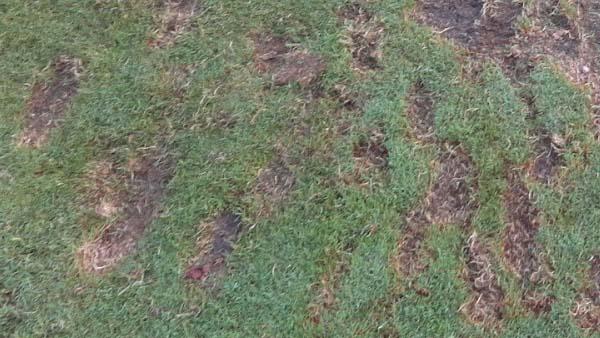 An ongoing study in its first year at Ohio State University could help determine whether warm-season grasses are a viable option for some high-traffic areas on golf courses during times of summer stress.
An ongoing study in its first year at Ohio State University could help determine whether warm-season grasses are a viable option for some high-traffic areas on golf courses during times of summer stress.Researchers at Ohio State will measure the viability and recuperative ability of four varieties of Bermudagrass for use during the summer playing season on golf course teeing grounds as well as practice range tees. The study, which is being conducted by OSU program coordinator Matt Williams, sports turf specialist Pam Sherratt and associate professor John Street, Ph.D., in conjunction with the USGA, also could shed light on whether any or all of those Bermuda varieties could be used to cover high school football practice fields.
"We're trying to find periods when we can use Bermudagrass on driving range tees, tee boxes and for practice fields to let them get off the cool-season grasses until October," Williams said.
After meeting with regional USGA Green Section agronomist Keith Happ last September, Ohio State researchers in March rolled out new plots of Patriot, Riviera, Latitude 36 and Northbridge Bermudagrass sod. Cup cutters and two-drum roller from Europe eventually will be used to simulate stress that the turf would be exposed to on a teeing area, Williams said. The roller, a contraption from the British company Sisis, has two drums, one of which spins faster than the other simulating traffic and divot wear.
The project hasn't been without its challenges so far. Since sodding took place in March, lingering winter conditions resulted in winter kill that necessitated resodding some isolated areas. Subsequently, prevailing cool summer conditions have forced researchers to maintain the turf at higher heights of cut than they had hoped for.
"This has not been a good Bermuda summer in Ohio," said Williams, who joked that Happ might have been turned down for the research if he'd asked after this year's winter rather than before it. "We've had plenty of water, but it's been mild, and the temperatures just have not been up there where it would thrive. We've spent the summer nursing it into condition."
Although this past five months have been an inhospitable one for growing Bermuda in Ohio, Williams said the research should be fruitful in the long term and could yield groundbreaking information for this part of the country. For example, a 250-mile stretch of Interstate 71 connects Ohio's three largest cities - Cleveland, Columbus and Cincinnati. The average high temperatures in August - 80 degrees in Cleveland, 83 in Columbus and 84 in Cincinnati - are far greater, especially for those desiring to grow Bermudagrass.
In Cincinnati, sports turf manager Darian Daily is growing Bermuda at the Bengals' practice facility outside Paul Brown Stadium. But does that mean other locations throughout the state will have the same or similar success? Time will tell, Williams said.
"The farther north you go, every degree counts," he said.
"I think 90 miles (the approximate distance between Columbus and Cincinnati and Columbus and Cleveland) is significant. It might not seem like it going from Cincinnati to Columbus, but another 90 miles and you're in Cleveland. The farther north you go, every degree counts."
Although this project is in its early stages, Bermudagrass research has been conducted at Ohio State for many years, and Williams isn't concerned that cooler conditions will inhibit the newest trials. In fact, long-term weather trends will only help validate the research.
"This is my eighth season here. We have 10,000 square feet of Bermuda here, and this is the first sign of winter kill here since I've been here," he said. "Are we going to see it moving forward? Is it going to be one out of three years, or one out of 10 years? Those things will help people evaluate whether it is worth it to grow Bermuda where they are."
Previous Bermudagrass research at Ohio State by Street that began as long as 15 years ago has included looking into prolonging color retention beyond summer.
"Can we extend the color and still beat it up into late September or early October?" Williams said. "You can't play football on it, or use it on a tee if you can't beat it up."

